Effect of Filler Wire Feed Rate on the Formation of Porosity in Laser Welded Joints of Magnesium Alloy AZ31B–H24
Abstract
:1. Introduction
2. Experiment
2.1. Material Characterization
2.2. Laser Equipment and Welding Parameters
2.3. Preparation of the Welded Joints
3. Results
3.1. Welds Appearance
3.2. Cross-Sections
3.3. Light and Electron Microscopy
3.4. EDS Analysis
4. Computed Tomography
5. Mechanical Tests
5.1. Microhardness of the Weld Joints
5.2. Tensile Test
5.3. Analysis of the Fracture Surfaces
6. Conclusions
- -
- in all welded joints, the microstructure of the weld metal is formed by fine dendrites, while the base material is characterized by polyhedral grains;
- -
- according to elemental mapping analysis, it is evident that the wrought alloy is not homogenous in composition; larger clusters contain high concentrations of Al and Zn, while in smaller ones, the presence of a high amount of Al and Mn is observed;
- -
- clear segregation of aluminium, manganese, and zinc can be observed in the EDS maps and the local EDS line profile measurements. The precipitates formed were rich in Al and Mn or Al and Zn, compared to the matrix. They also show a large decrease in the Mg content to minimum values ranging from 10 to 60 wt.% in the precipitates;
- -
- the largest width of the weld metal (2.25 mm), as expected, was measured when the filler wire feed rate was 130 cm/min. On the contrary, the smallest width (1.92 mm) was recorded using a filler wire feed rate of 0 cm/min,
- -
- the highest average microhardness of the weld metal (82.5 HV0.1) was measured if the filler wire feed rate was 130 cm/min. Conversely, by not using filler wire, the average microhardness dropped to 79.7 HV0.1.
- -
- the tensile test revealed that weld metal no.1 (220 MPa) and no. 2 (224 MPa) had a higher strength than the base material. At the last weld joint, no. 3, which was created without the use of filler wire, a fracture occurred in the weld metal. The measured tensile strength was only 154 MPa.
Funding
Institutional Review Board Statement
Informed Consent Statement
Data Availability Statement
Conflicts of Interest
References
- Zeng, R.-C.; Dietzel, W.; Zettler, R.; Gan, W.-M.; Sun, X.-X. Microstructural evolution and delayed hydride cracking of FSW-AZ31 magnesium alloy during SSRT. Trans. Nonferrous Met. Soc. China 2014, 24, 3060–3069. [Google Scholar] [CrossRef]
- Vyskoc, M. Influence of shielding gases on porosity during laser welding of AZ31B magnesium alloy. Met. Mater. 2021, 59, 401–414. [Google Scholar] [CrossRef]
- Chen, J.; Liu, T.; Lu, L.; Zhang, Y.; Zeng, W. Microstructure and mechanical property of rolled-weld magnesium alloy AZ31. Mater. Des. 2012, 36, 577–583. [Google Scholar] [CrossRef]
- IPolmea. Mg alloys and applications. Mater. Sci. Technol. 1994, 10, 1–16. [Google Scholar] [CrossRef]
- Yoo, M.; Agnew, S.; Morris, J.; Ho, K. Non-basal slip systems in HCP metals and alloys: Source mechanisms. Mater. Sci. Eng. A 2001, 319–321, 87–92. [Google Scholar] [CrossRef]
- Lin, C.M.; Tsai, H.L.; Lee, C.L.; Chou, D.S.; Huang, J.C. Evolution of microstructures and properties of magnesium alloy weldments produced with CO2 laser process. Mater. Sci. Eng. A 2012, 548, 12–18. [Google Scholar] [CrossRef]
- Lin, Y.-C.; Liu, J.-J.; Lin, B.-Y.; Lin, C.-M.; Tsai, H.-L. Effects of process parameters on strength of Mg alloy AZ61 friction stir spot welds. Mater. Des. 2012, 35, 350–357. [Google Scholar] [CrossRef]
- Lin, C.M.; Liu, J.J.; Tsai, H.L.; Cheng, C.M. Evolution of microstructures and mechanical properties of AZ31B magnesium alloy weldment with active oxide fluxes and GTAW process. J. Chin. Inst. Eng. 2011, 34, 1013–1023. [Google Scholar] [CrossRef]
- Quan, Y.; Chen, Z.; Gong, X.; Yu, Z. CO2 laser beam welding of dissimilar magnesium-based alloys. Mater. Sci. Eng. A 2008, 496, 45–51. [Google Scholar] [CrossRef]
- Mahendran, G.; Balasubramanian, V.; Senthilvelan, T. Developing diffusion bonding windows for joining AZ31B magnesium–AA2024 aluminium alloys. Mater. Des. 2009, 30, 1240–1244. [Google Scholar] [CrossRef]
- Abderrazak, K.; Salem, W.B.; Mhiri, H.; Lepalec, G.; Autric, M. Modelling of CO2 laser welding of magnesium alloys. Opt. Laser Technol. 2008, 40, 581–588. [Google Scholar] [CrossRef]
- Liu, H.-T.; Zhou, J.-X.; Zhao, D.-Q.; Liu, Y.-T.; Wu, J.-H.; Yang, Y.-S.; Ma, B.-C.; Zhuang, H.-H. Characteristics of AZ31 Mg alloy joint using automatic TIG welding. Int. J. Miner. Met. Mater. 2017, 24, 102–108. [Google Scholar] [CrossRef]
- Min, D.; Shen, J.; Lai, S.; Chen, J.; Xu, N.; Liu, H. Effects of heat input on the low power Nd:YAG pulse laser conduction weldability of magnesium alloy AZ61. Opt. Lasers Eng. 2010, 49, 89–96. [Google Scholar] [CrossRef]
- Li, F.; Zeng, X.; Cao, G. Investigation of microstructure characteristics of the CVCDEed AZ31 magnesium alloy. Mater. Sci. Eng. A 2015, 639, 395–401. [Google Scholar] [CrossRef]
- Yu, L.; Nakata, K.; Liao, J. Weld porosity in fibre laser weld of thixomolded heat resistant Mg alloys. Sci. Technol. Weld. Join. 2009, 14, 554–558. [Google Scholar] [CrossRef]
- Salleh, N.M.; Ishak, M.; Romlay, F.R. Effect of fiber laser parameters on laser welded AZ31B Magnesium alloys. MATEC Web Conf. 2017, 90, 1032. [Google Scholar] [CrossRef] [Green Version]
- Dhari, M.; Autric, M.; Masse, J.E.; Mathieu, J.F.; Barreau, G. Laser Welding of AZ91 and WE 43 Magnesium Alloys for Automotive and Aerospace Industries. Adv. Eng. Mater. 2001, 3, 504–507. [Google Scholar] [CrossRef]
- Ahn, J.; Chen, L.; He, E.; Davies, C.; Dear, J. Effect of filler metal feed rate and composition on microstructure and mechanical properties of fibre laser welded AA 2024-T3. J. Manuf. Process. 2017, 25, 26–36. [Google Scholar] [CrossRef]
- Cao, X.J.; Jahazi, M.; Immarigeon, J.P.; Wallace, W. A review of laser welding techniques for magnesium alloys. J. Mater. Process. Technol. 2006, 171, 188–204. [Google Scholar] [CrossRef]
- Dilthey, U.; Haferkamp, H.; Niemeyer, M.; Trager, G. Laser and EB Welding of Magnesium Alloys; IIW Document No. IV-701-98; American Institute of Welding: Miami, FL, USA, 1998. [Google Scholar]
- Haferkamp, H.; Goede, M.; Bormann, A.; Cordini, P. Laser beam welding of magnesium alloys—New possibilities using filler wire and arc welding. Proc. LANE Laser Assist. Net Shape Eng. 2001, 3, 333–338. [Google Scholar]
- Sahul, M.; Sahul, M.; Lokaj, J. Lokaj. Effect of surface layer on the properties of AZ31 magnesium alloy welded joints. Mater. Today Proc. 2016, 3, 1150–1155. [Google Scholar] [CrossRef]
- Harooni, M.; Ma, J.; Carlson, B.; Kovacevic, R. Two-pass laser welding of AZ31B magnesium alloy. J. Mater. Process. Technol. 2015, 216, 114–122. [Google Scholar] [CrossRef]
- Deng, A.; Chen, H.; Zhang, Y.; Liu, Y.; Yang, X.; Zhang, B. Effect of filler materials on the porosity formation of aluminum alloy by laser welding with filler wire. Opt. Laser Technol. 2023, 159, 109000. [Google Scholar] [CrossRef]
- Dongxia, Y.; Xiaoyan, L.; Dingyong, H.; Zuoren, N.; Hui, H. Huang. Optimization of weld bead geometry in laser welding with filler wire process using Taguchi’s approach. Opt. Laser Technol. 2012, 44, 2020–2025. [Google Scholar] [CrossRef]
- Huang, W.; Chen, S.; Xiao, J.; Jiang, X.; Jia, Y. Investigation of filler wire melting and transfer behaviors in laser welding with filler wire. Opt. Laser Technol. 2021, 134, 106589. [Google Scholar] [CrossRef]
- Feng, J.; Li, L.; Chen, Y.; Lei, Z.; Qin, H.; Li, Y. Effects of welding velocity on the impact behavior of droplets in gas metal arc welding. J. Mater. Process. Technol. 2012, 212, 2163–2172. [Google Scholar] [CrossRef]
- Liu, S.; Liu, F.; Zhang, H.; Shi, Y. Analysis of droplet transfer mode and forming process of weld bead in CO2 laser–MAG hybrid welding process. Opt. Laser Technol. 2012, 44, 1019–1025. [Google Scholar] [CrossRef]
- Yu, Y.; Huang, W.; Wang, G.; Wang, J.; Meng, X.; Wang, C.; Yan, F.; Hu, X.; Yu, S. Investigation of melting dynamics of filler wire during wire feed laser welding. J. Mech. Sci. Technol. 2013, 27, 1097–1108. [Google Scholar] [CrossRef]
- Lee, W.; Yeon, Y.; Jung, S. Joint properties of friction stir welded AZ31B– H24 magnesium alloy. Mater. Sci. Technol. 2003, 19, 785–790. [Google Scholar] [CrossRef]
- Chiuzuli, F.R.; Batistão, B.F.; Bergmann, L.A.; de Alcântara, N.G.; dos Santos, J.F.; Klusemann, B.; Gargarella, P. Effect of the gap width in AZ31 magnesium alloy joints obtained by friction stir welding. J. Mater. Res. Technol. 2021, 15, 5297–5306. [Google Scholar] [CrossRef]
- Lampman, S. Weld Integrity and Performance: A Source Book Adapted from ASM International Handbooks, Conference Proceedings, and Technical Books. ASM Int. 1997, 417, 9781615032044. [Google Scholar]
- Vyskoč, M. Influence of Shielding Gas on Weldability of Non-Ferrous Metals by Laser. Ph.D. Thesis, Slovak University of Technology in Bratislava, Bratislava, Slovakia, 2018. [Google Scholar]
- Syed, W.U.H.; Li, L. Effects of wire feeding direction and location in multiple layer diode laser direct metal deposition. Appl. Surf. Sci. 2005, 248, 518–524. [Google Scholar] [CrossRef]
- Chen, Q.; Yan, H.; Chen, J.; Zeng, P.; Yu, Z.; Su, B. Laser Beam Welding of AZ31 Magnesium Alloy with Filler Strip. Mater. Manuf. Process. 2010, 25, 1227–1232. [Google Scholar] [CrossRef]
- Baumgart, P. Drawn magnesium wire for robotic welding and for mechanical applications. In Magnesium: Proceedings of the 6th International Conference Magnesium Alloys and Their Applications; Wiley-VCH Verlag GmbH & Co. KgaA: Weinheim, Germany, 2005; ISBN 9783527309757. [Google Scholar]
- Quan, Y.; Chen, Z.; Gong, X.; Yu, Z. Effects of heat input on microstructure and tensile properties of laser welded magnesium alloy AZ31. Mater. Charact. 2008, 59, 1491–1497. [Google Scholar] [CrossRef]
- Tadamalle, A.; Ramjee, E.; Reddy, Y. Influence of laser welding process parameters on weld pool geometry and duty cycle. Adv. Prod. Eng. Manag. 2013, 8, 52–60. [Google Scholar] [CrossRef] [Green Version]
- El-Batahgy, A.-M. Effect of laser welding parameters on fusion zone shape and solidification structure of austenitic stainless steels. Mater. Lett. 1997, 32, 155–163. [Google Scholar] [CrossRef]
- Matsuoka, S.; Okamoto, Y.; Okada, A. Influence of Weld Bead Geometry on Thermal Deformation in Laser Micro-Welding. Procedia CIRP 2013, 6, 492–497. [Google Scholar] [CrossRef] [Green Version]
- Kuo, T.-Y.; Lin, Y.-T. Effects of Shielding Gas Flow Rate and Power Waveform on Nd:YAG Laser Welding of A5754-O Aluminum Alloy. Mater. Trans. 2006, 47, 1365–1373. [Google Scholar] [CrossRef] [Green Version]
- Rakshith, M.; Seenuvasaperumal, P. Review on the effect of different processing techniques on the microstructure and mechanical behaviour of AZ31 Magnesium alloy. J. Magnes. Alloy. 2021, 9, 1692–1714. [Google Scholar]
- Gao, M.; Wang, H.; Hao, K.; Mu, H.; Zeng, X. Evolutions in microstructure and mechanical properties of laser lap welded AZ31 magnesium alloy via beam oscillation. J. Manuf. Process. 2019, 45, 92–99. [Google Scholar] [CrossRef]
- Coelho, R.; Kostka, A.; Pinto, H.; Riekehr, S.; Koçak, M.; Pyzalla, A. Microstructure and mechanical properties of magnesium alloy AZ31B laser beam welds. Mater. Sci. Eng. A 2008, 485, 20–30. [Google Scholar] [CrossRef]
- Chowdhury, S.H.; Chen, D.L.; Bhole, S.D.; Powidajko, E.; Weckman, D.C.; Zhou, Y. Fiber Laser Welded AZ31 Magnesium Alloy: The Effect of Welding Speed on Microstructure and Mechanical Properties. Met. Mater. Trans. A 2012, 43, 2133–2147. [Google Scholar] [CrossRef]
- Hao, K.; Wang, H.; Gao, M.; Wu, R.; Zeng, X. Laser welding of AZ31B magnesium alloy with beam oscillation. J. Mater. Res. Technol. 2019, 8, 3044–3053. [Google Scholar] [CrossRef]
- Kou, S. Welding Metallurgy, 2nd ed.; John Wiley & Sons, Inc.: Hoboken, NJ, USA, 2003. [Google Scholar]
- Zhang, X.; Cao, Z. Effects of pulse shaping on Nd:YAG laser spot welds in an AZ31 magnesium alloy. Opt. Lasers Eng. 2019, 119, 1–8. [Google Scholar] [CrossRef]
- Song, G.; Diao, Z.; Lv, X.; Liu, L. TIG and laser–TIG hybrid filler wire welding of casting and wrought dissimilar magnesium alloy. J. Manuf. Process. 2018, 34, 204–214. [Google Scholar] [CrossRef]
- Cao, X.; Wallace, W.; Immarigeon, J.P.; Poon, C. Research and progress in laser welding of wrought aluminum alloys. I. Laser welding processes. Mater. Manufact. Process. 2003, 18, 1–22. [Google Scholar] [CrossRef]
- Aghion, E.; Bronfin, B. Magnesium Alloys Development towards the 21st Century. Mater. Sci. Forum 2000, 350–351, 19–30. [Google Scholar] [CrossRef]
- Polmear, I.J. Light Alloys: Metallurgy of the Light Metals, 3rd ed.; Arnold: London, UK, 1995; p. 207. [Google Scholar]
- Jutter, S. Arc Welding of Magnesium alloys. In Proceedings of the IIW Seminar: Trends in Welding of Lightweight Automotive and Railroad Vehicles, Wels, Austria, 26–28 February 1997. [Google Scholar]
- Pastor, M.; Zhao, H.; DebRoy, T. Continuous wave-Nd:yttrium aluminium–garnet laser welding of AM60B magnesium alloys. J. Laser Appl. 2000, 12, 91–100. [Google Scholar] [CrossRef] [Green Version]
- Haferkamp, H.; von Alvensleben, M.; Goede, M.; Niemeyer, J.; Bunte, J. Fatigue strength of laser beam welded magnesium alloys. In Proceedings of the 32 ISATA, International Symposium on Automotive Technology and Automation: Advances in Automotive and Transportation Technology and Practice for the 21st Century, Vienna, Austria, 14–18 June 1999; pp. 389–397. [Google Scholar]
- Marya, M.; Edwards, G. The laser welding of magnesium alloy AZ91. Weld. World 2000, 44, 31–37. [Google Scholar]
- Zhao, H.; DebRoy, T. Pore formation during laser beam welding of die-cast magnesium alloy AM60B—Mechanism and remedy. Weld. J. 2001, 80, 204S–210S. [Google Scholar]
- Xiao, R.; Zhang, X. Problems and issues in laser beam welding of aluminum–lithium alloys. J. Manuf. Process. 2014, 16, 166–175. [Google Scholar] [CrossRef]
- Wu, S.C.; Yu, X.; Zuo, R.Z.; Zhang, W.H.; Xie, H.L.; Jiang, J.Z. Porosity, Element Loss, and Strength Model on Softening Behavior of Hybrid Laser Arc Welded Al-Zn-Mg-Cu Alloy with Synchrotron Radiation Analysis. Weld. J. 2013, 92, 64. [Google Scholar]
- Sato, S.; Matsumoto, J.; Okoshi, N. Effects of porosity on the fatigue strength of 5083 alloy butt-welds. J. Jpn. Inst. Light Met. 1976, 26, 398–405. [Google Scholar] [CrossRef]
- Takahashi, K.; Mehmetli, B.; Sato, S. Influence of shielding gas and laser irradiation conditions on porosity formation in CO2laser welding of aluminium alloy. Weld. Int. 1998, 12, 347–353. [Google Scholar] [CrossRef]
- Panwisawas, C.; Perumal, B.; Ward, R.M.; Turner, N.; Turner, R.P.; Brooks, J.W.; Basoalto, H.C. Basoalto. Keyhole formation and thermal fluid flow-induced porosity during laser fusion welding in titanium alloys: Experimental and modelling. Acta Materialia 2017, 126, 251–263. [Google Scholar] [CrossRef] [Green Version]
- Shen, J.; Wen, L.; Li, Y.; Min, D. Effects of welding speed on the microstructures and mechanical properties of laser welded AZ61 magnesium alloy joints. Mater. Sci. Eng. A 2013, 578, 303–309. [Google Scholar] [CrossRef]
- Lei, Z.; Bi, J.; Li, P.; Guo, T.; Zhao, Y.; Zhang, D. Analysis on welding characteristics of ultrasonic assisted laser welding of AZ31B magnesium alloy. Opt. Laser Technol. 2018, 105, 15–22. [Google Scholar] [CrossRef]
- Scintilla, L.D.; Tricarico, L.; Brandizzi, M.; Satriano, A.A. Nd:YAG laser weldability and mechanical properties of AZ31 magnesium alloy butt joints. J. Mater. Process. Technol. 2010, 210, 2206–2214. [Google Scholar] [CrossRef]
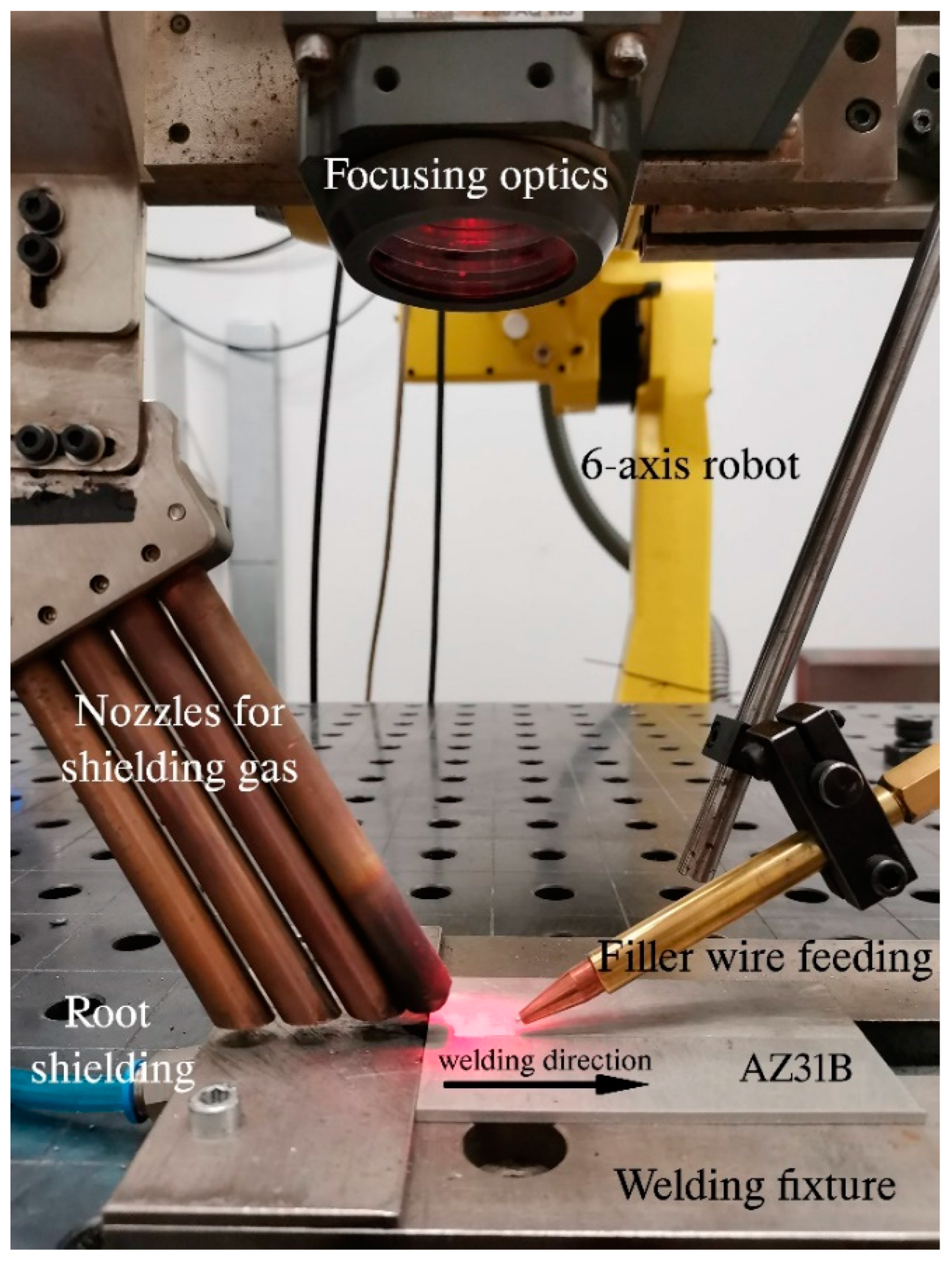

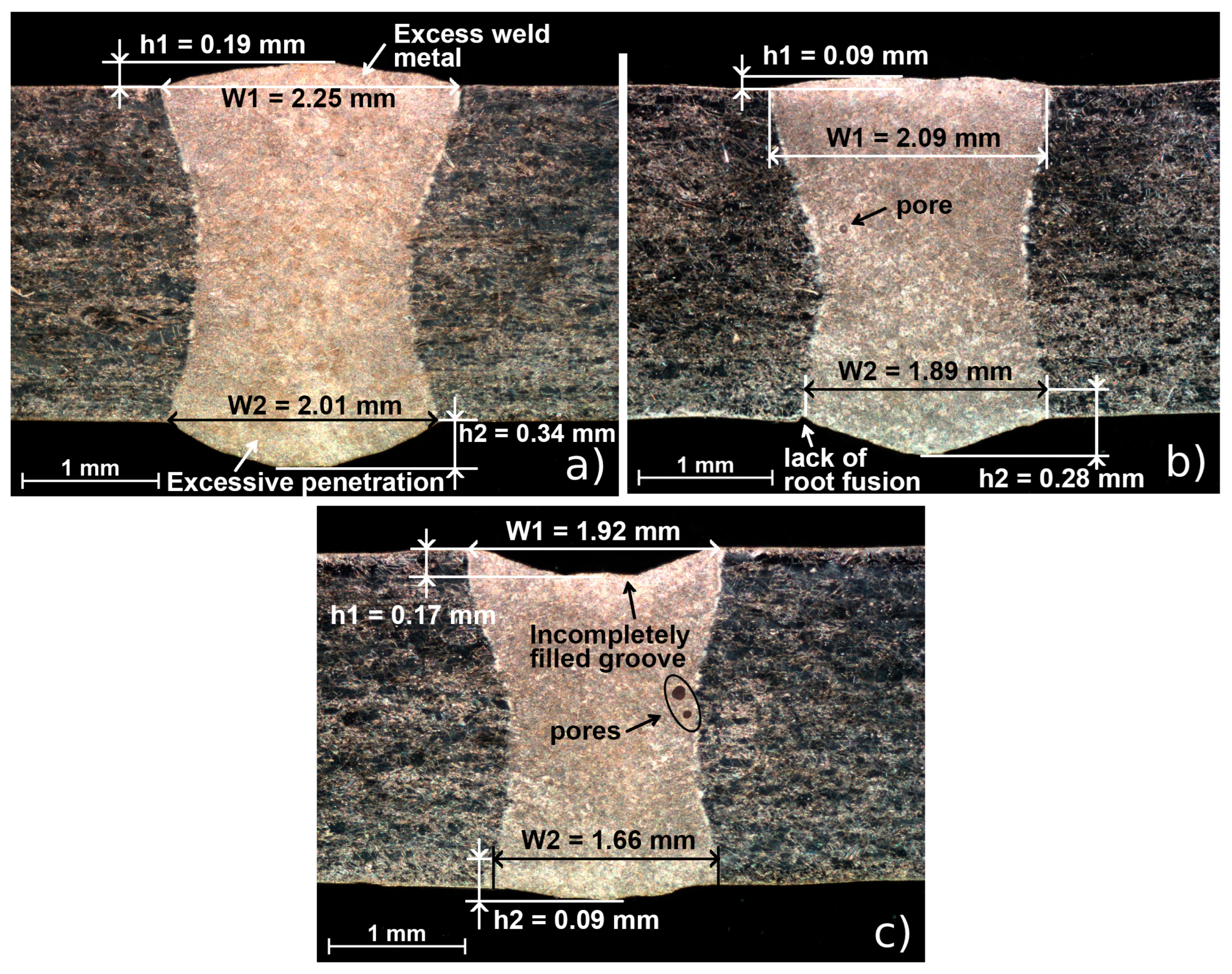



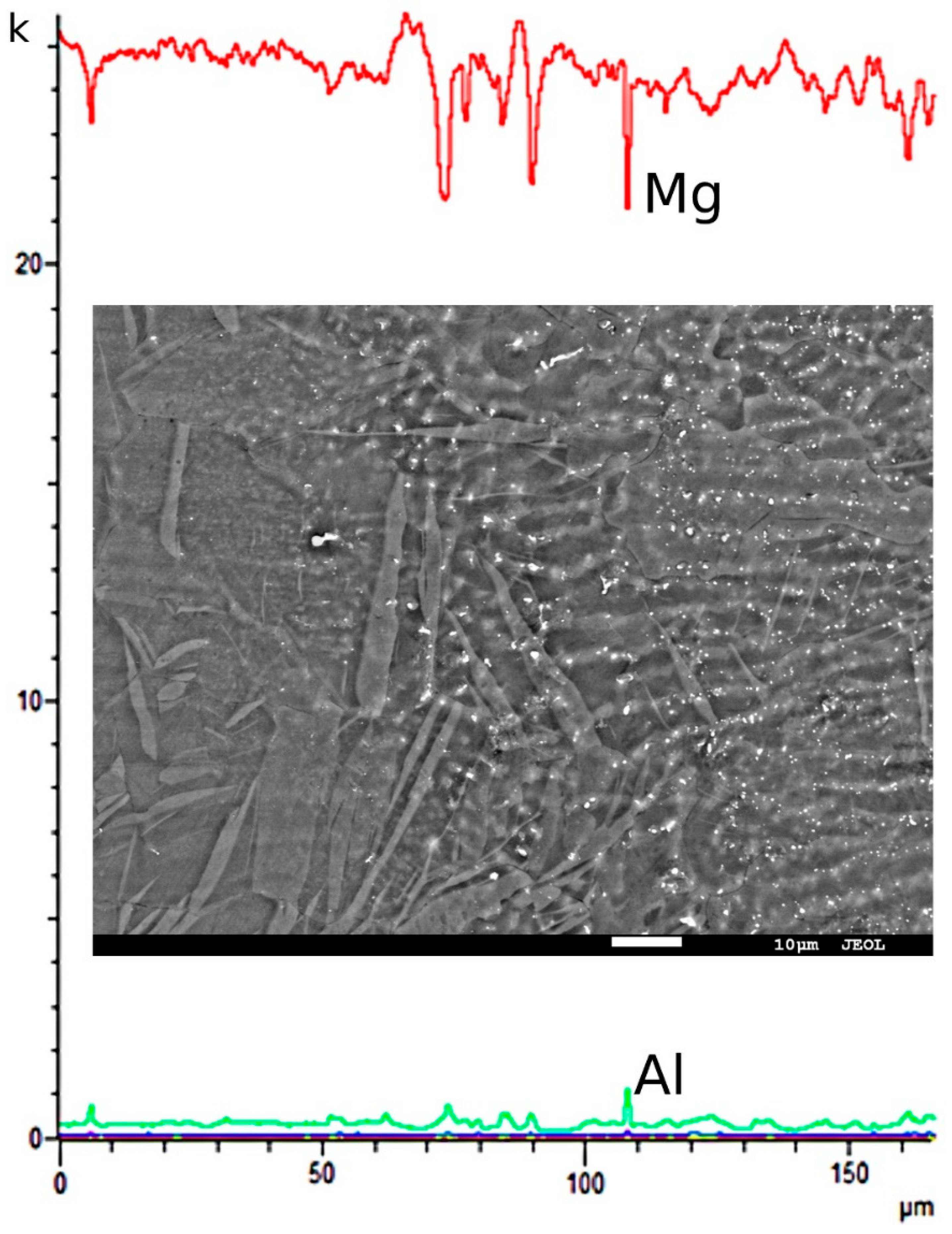
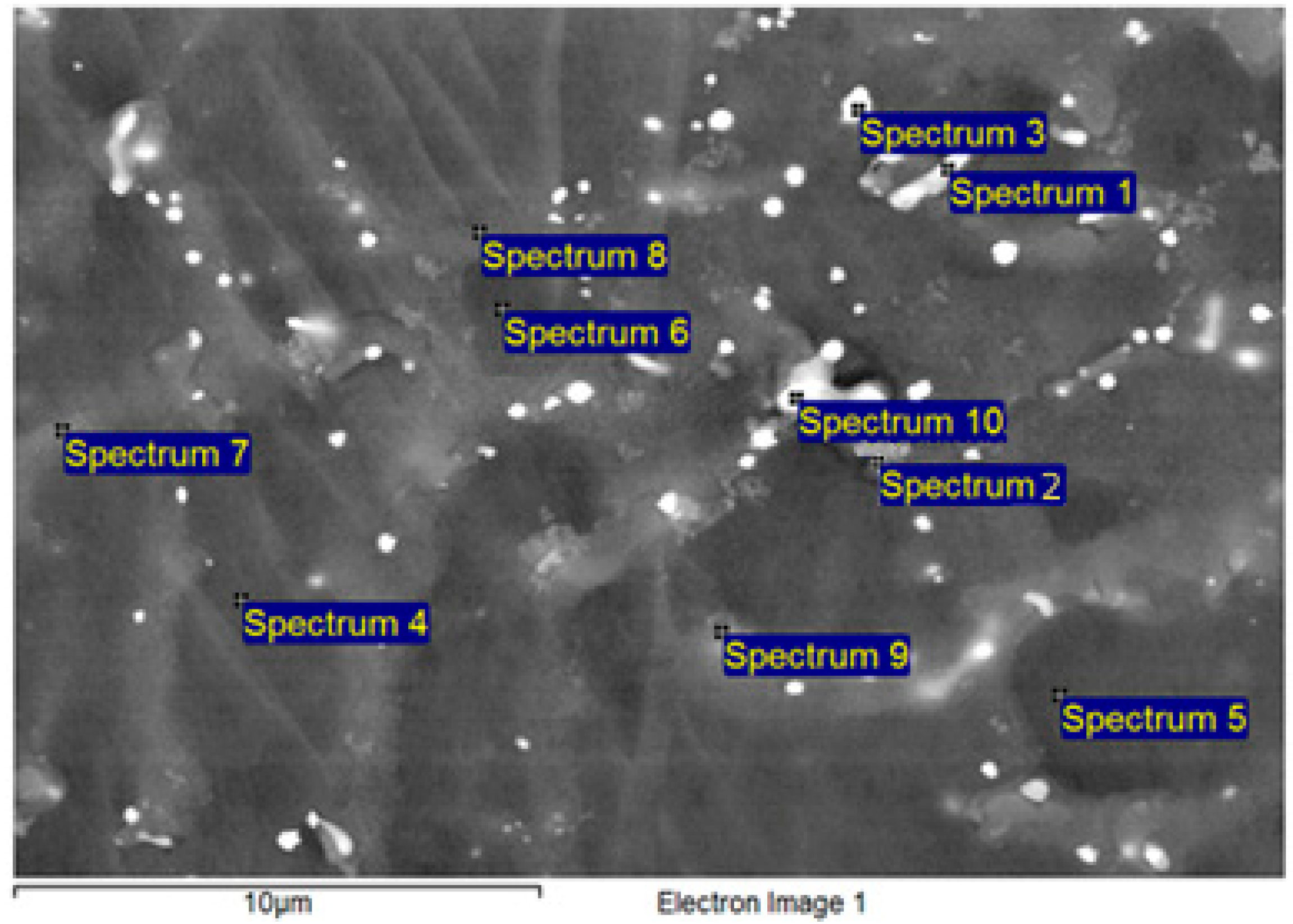

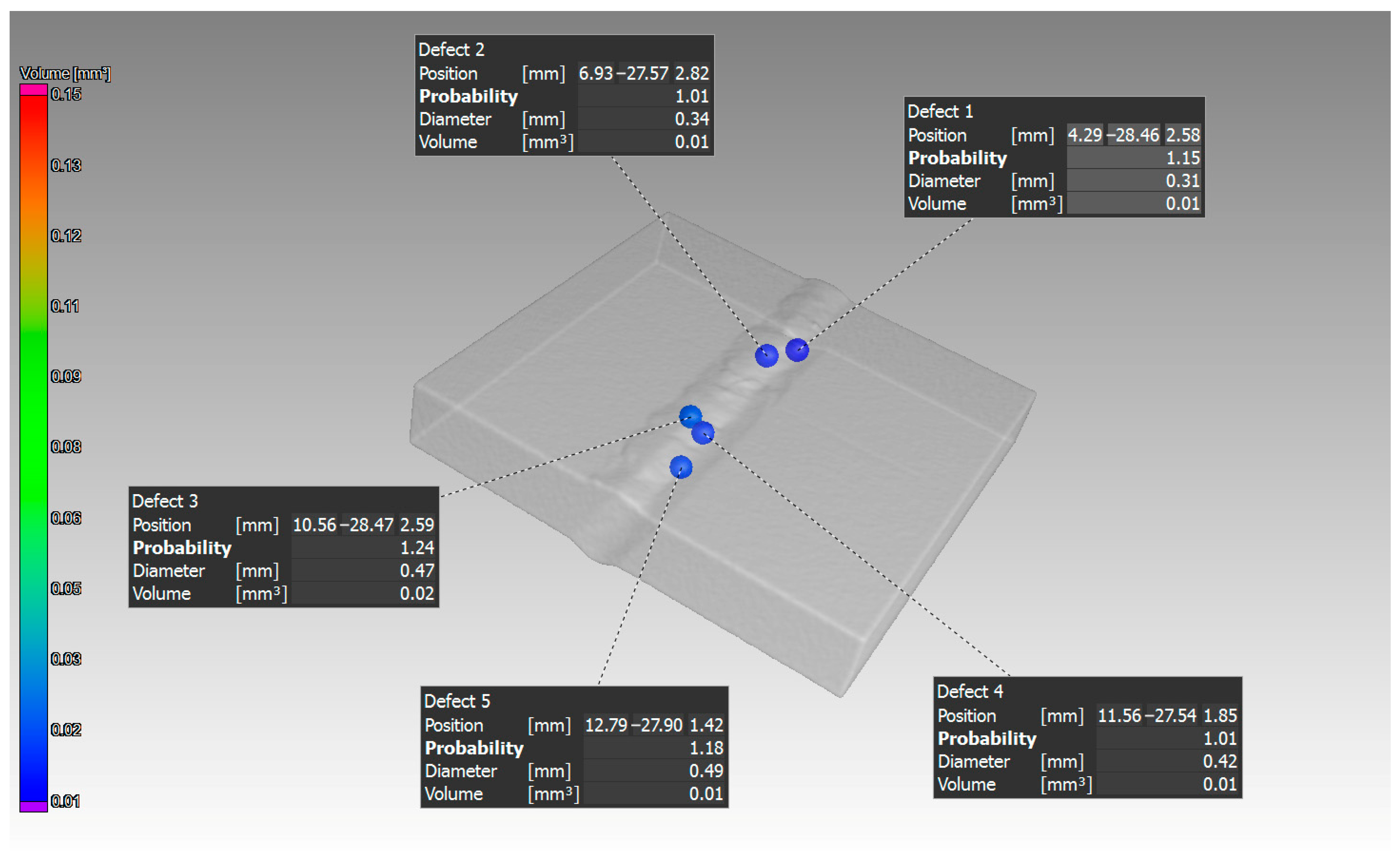
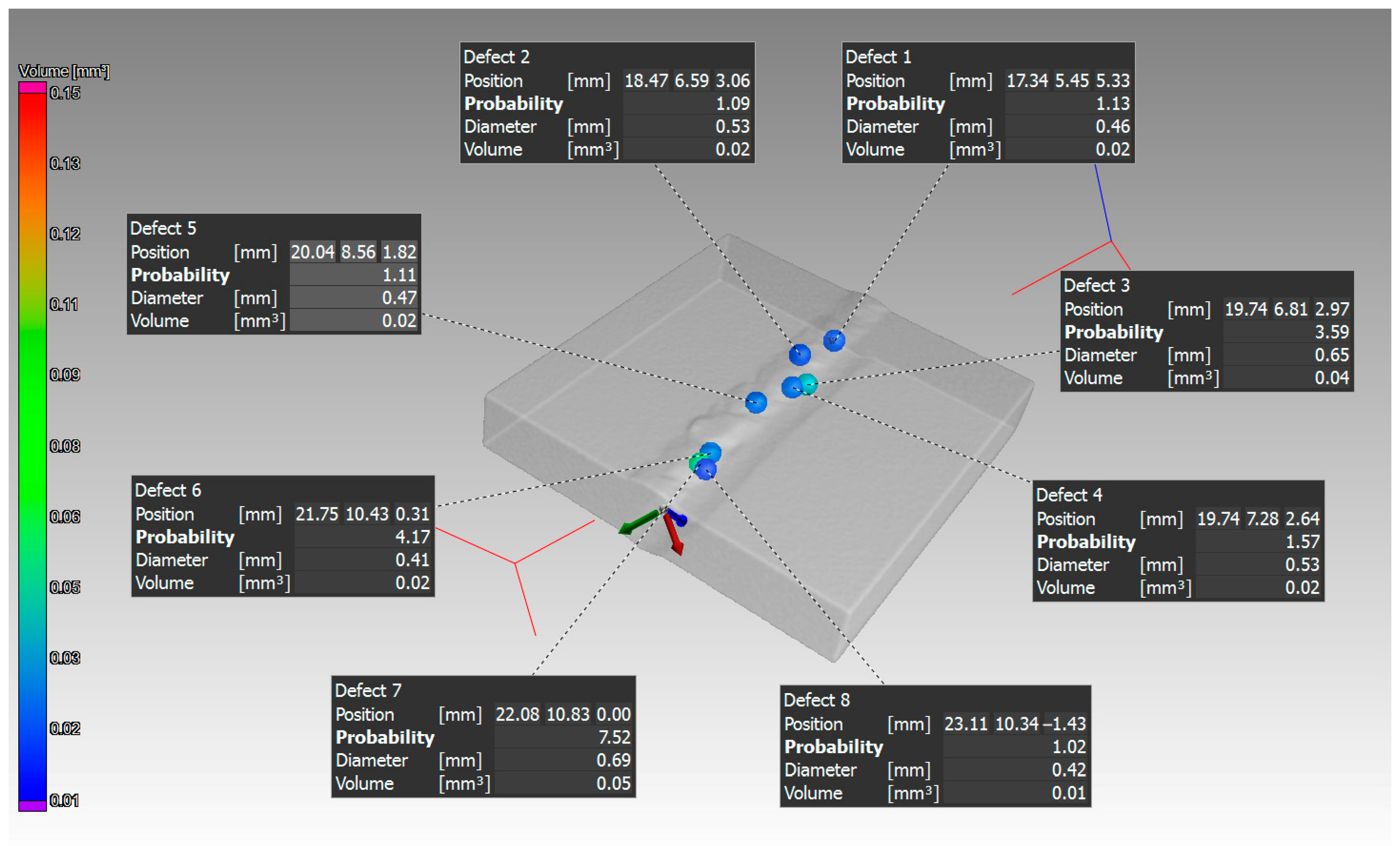

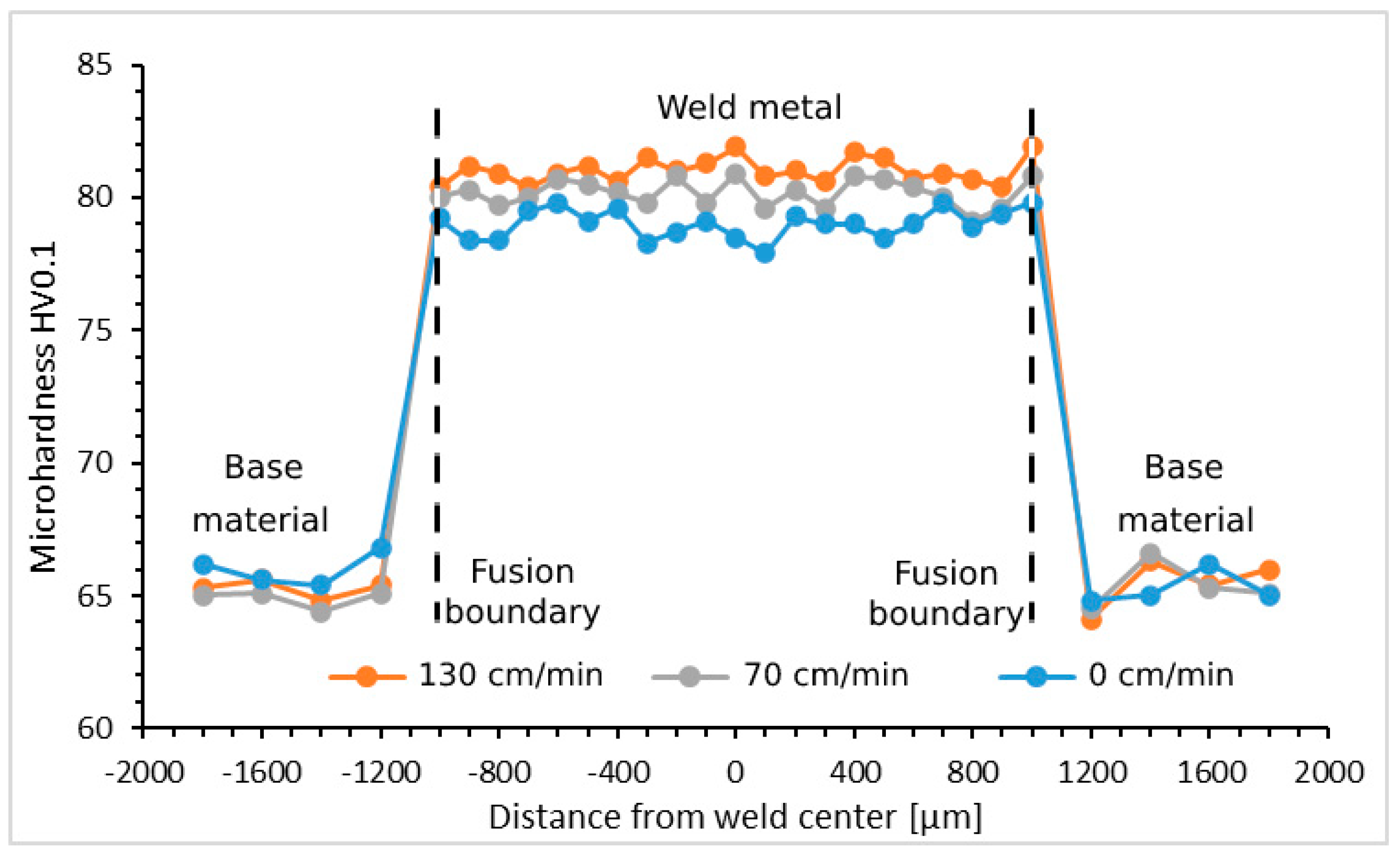

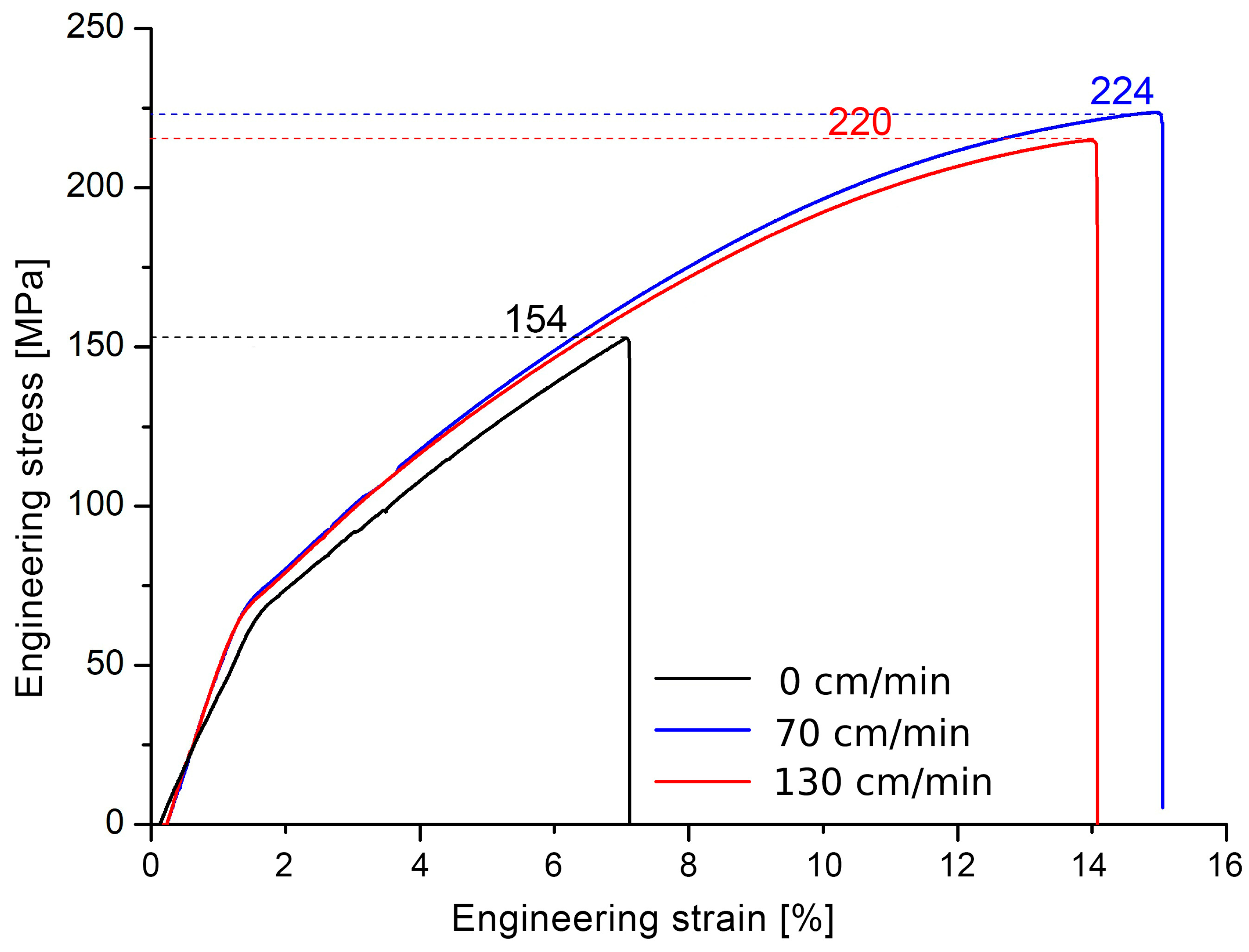
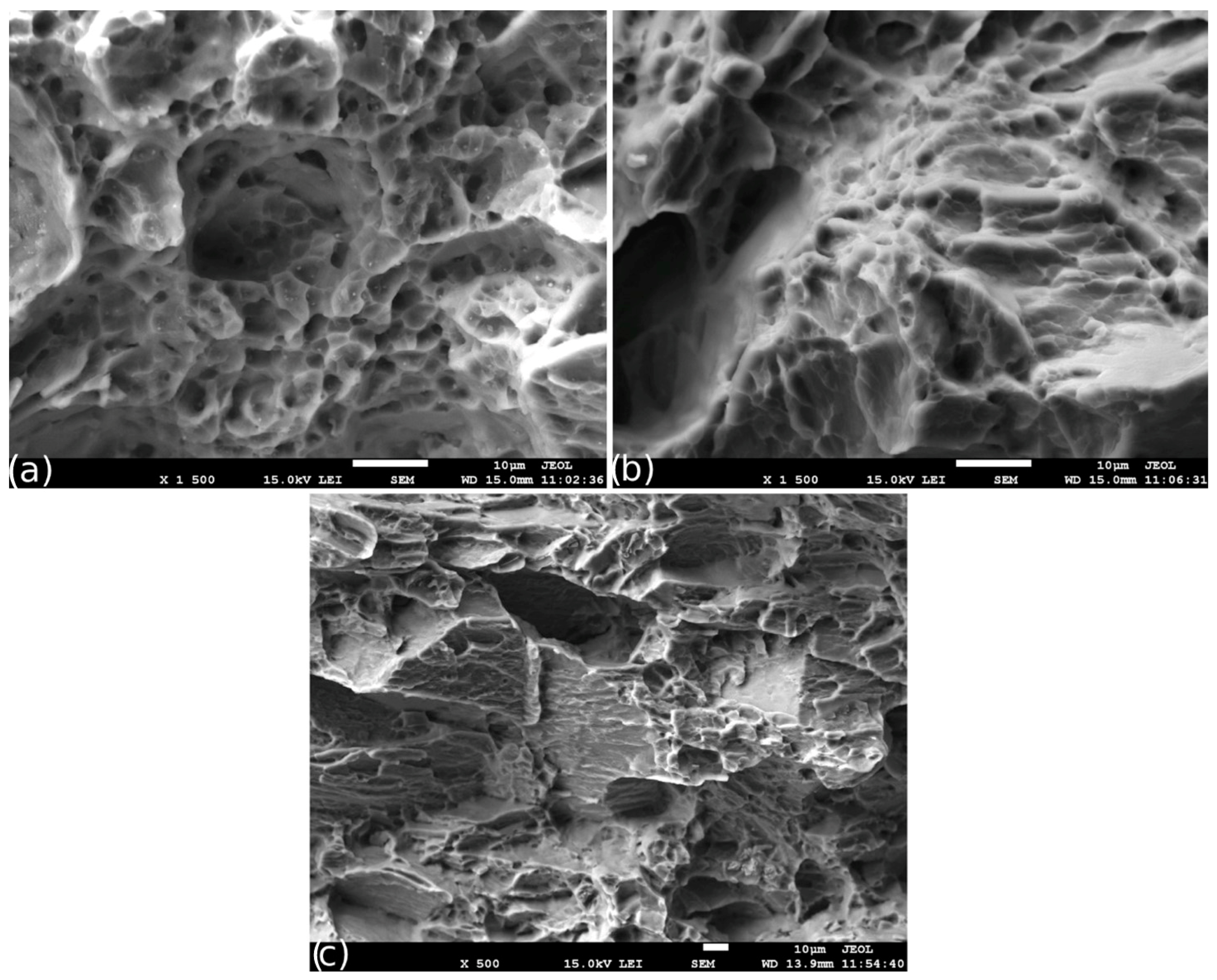
| Al | Zn | Mn | Si | Cu | Fe | Ni | Mg |
|---|---|---|---|---|---|---|---|
| 2.5–3.5 | 0.6–1.4 | ≤0.2 | 0.1 | 0.05 | ≤0.005 | ≤0.005 | Balance |
| Rm, MPa | Rp 0.2, MPa | A50, % | HV |
|---|---|---|---|
| 260 | 200 | 15 | 49 |
| Al | Zn | Si | Mn | Cu | Ni | Fe | Mg |
|---|---|---|---|---|---|---|---|
| 2.4–3.6 | 0.4–1.5 | 0.015 | 0.15–0.5 | 0.05 | 0.005 | 0.005 | Balance |
| No. | Laser Power [kW] | Welding Speed [mm/s] | Wire Feed Rate [cm/min] | Type of Shielding Gas | Shielding Gas Flow Rate [l/min] | Focusing [mm] |
|---|---|---|---|---|---|---|
| 1 2 3 | 1.5 1.5 1.5 | 35 35 35 | 140 70 0 | Ar Ar Ar | 24 24 24 | 0 0 0 |
| Spectrum | Mg [%] | Al [%] | Zn [%] | Si [%] | Mn [%] | O [%] |
|---|---|---|---|---|---|---|
| Spectrum 1 | 71.45 | 9.36 | 12.76 | 0.14 | 0.11 | 6.19 |
| Spectrum 2 | 67.23 | 15.19 | 10.71 | 0.26 | 0.08 | 6.52 |
| Spectrum 3 | 75.78 | 11.29 | 4.12 | 1.63 | 2.50 | 4.67 |
| Spectrum 4 | 95.83 | 1.49 | 0.44 | 0.09 | 0.23 | 1.92 |
| Spectrum 5 | 95.34 | 1.78 | 0.54 | 0.06 | 0.27 | 2.00 |
| Spectrum 6 | 93.65 | 2.56 | 1.22 | 0.09 | 0.28 | 2.20 |
| Spectrum 7 | 90.21 | 4.36 | 1.59 | 0.14 | 0.15 | 3.56 |
| Spectrum 8 | 93.85 | 2.23 | 0.55 | 0.10 | 0.21 | 3.06 |
| Spectrum 9 | 85.90 | 4.51 | 1.35 | 0.26 | 0.28 | 7.70 |
| Spectrum 10 | 58.64 | 16.04 | 13.42 | 0.22 | 2.93 | 8.75 |
Disclaimer/Publisher’s Note: The statements, opinions and data contained in all publications are solely those of the individual author(s) and contributor(s) and not of MDPI and/or the editor(s). MDPI and/or the editor(s) disclaim responsibility for any injury to people or property resulting from any ideas, methods, instructions or products referred to in the content. |
© 2023 by the author. Licensee MDPI, Basel, Switzerland. This article is an open access article distributed under the terms and conditions of the Creative Commons Attribution (CC BY) license (https://creativecommons.org/licenses/by/4.0/).
Share and Cite
Vyskoč, M. Effect of Filler Wire Feed Rate on the Formation of Porosity in Laser Welded Joints of Magnesium Alloy AZ31B–H24. Metals 2023, 13, 460. https://doi.org/10.3390/met13030460
Vyskoč M. Effect of Filler Wire Feed Rate on the Formation of Porosity in Laser Welded Joints of Magnesium Alloy AZ31B–H24. Metals. 2023; 13(3):460. https://doi.org/10.3390/met13030460
Chicago/Turabian StyleVyskoč, Maroš. 2023. "Effect of Filler Wire Feed Rate on the Formation of Porosity in Laser Welded Joints of Magnesium Alloy AZ31B–H24" Metals 13, no. 3: 460. https://doi.org/10.3390/met13030460






